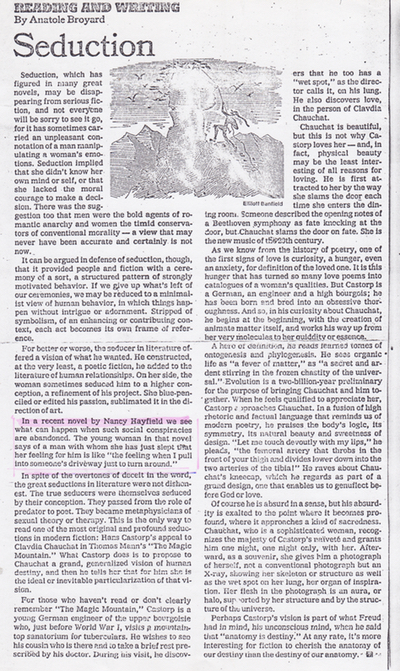
Reading and Writing
Seduction
Seduction, which has figured in many great novels, may be disappearing from serious fiction, and not everyone will be sorry to see it go, for it has sometimes carried an unpleasant connotation of a man manipulating a woman’s emotions. Seduction implied that she didn’t know her own mind or self, or that she lacked the moral courage to make a decision. There was the suggestion too that men were the bold agents of romantic anarchy and women were the timid conservators of conventional morality—a view that may never have been accurate and certainly is not now.
It can be argued in defense of deduction, though, that it provided people and fiction with a ceremony of a sort, a structured pattern of strongly motivated behavior. If we give up what’s left of our ceremonies, we may be reduced to a minimalist view of human behavior, in which things happen without intrigue or adornment. Stripped of symbolism, of an enhancing or contributing context, each act becomes its own frame of reference.
For better or worse, the seducer in literature offered a vision of what he wanted. He constructed, at the very least, a poetic fiction; he added to the literature of human relationships. On her side, the woman sometimes seduced him to a higher conception, a refinement of his project. She blue-penciled or edited his passion, sublimated it in the direction of art.
In a recent novel by Nancy Hayfield we see what can happen when such social conspiracies are abandoned. The young woman in that novel says of a man with whom she has just slept that her feeling for him is like “the feeling when I pull into someone’s driveway just to turn around.”
In spite of the overtones of deceit in the word, the great seductions in literature were not dishonest. The true seducers were themselves seduced by their conception. They passed from the role of predator to poet. They became metaphysicians of sexual theory or therapy. This is the only way to read one of the most original and profound seductions in modern fiction: Hans Castorp’s appeal to Clavdia Chauchat in Thomas Mann’s The Magic Mountain. What Castorp does is to propose to Chauchat a grand, generalized vision of human destiny, and then he tells her that for him she is the ideal or inevitable particularization of that vision.
For those who haven’t read or don’t clearly remember The Magic Mountain. Castorp is a young German engineer of the upper bourgoisie who, just before World War I, visits a mountaintop sanatorium for tuberculars. He wishes to see his cousin who is there and to take a brief rest prescribed by his doctor. During his visit, he discovers that he too has a “wet spot,” as the director calls it, on his lung. He also discovers love, in the person of Clavdia Chauchat.
Chauchat is beautiful, but this is not why Castorp loves her—and, in fact, physical beauty may be the least interesting of all reasons for loving. He is first attracted to her by the way she slams the door each time she enters the dining room. Someone described the opening notes of a Beethoven symphony as fate knocking at the door, but Chauchat slams the door on fate. She is the new music of the 20th century.
As we know from the history of poetry, one of the first signs of love is curiosity, a hunger, even an anxiety, for definition of the loved one. It is this hunger that has turned so many love poems into catalogues of a woman’s qualities. But Castorp is a German, an engineer and a high bourgois; he has been born and bred into an obsessive thoroughness. And so, in his curiosity about Chauchat, he begins at the beginning, with the creation of animate matter itself, and works his way up from her very molecules to her quiddity or essence.
A hero of definition, he reads learned tomes of ontogenesis and phylogenesis. He sees organic life as “a fever of matter,” as “a secret and ardent stirring in the frozen chastity of the universal.” Evolution is a two-billion-year preliminary for the purpose of bringing Chauchat and him together. When he feels qualified to appreciate her, Castorp approaches Chauchat. In a fusion of high rhetoric and factual language that reminds us of modern poetry, he praises the body’s logic, its symmetry, its natural beauty and sweetness of design. “Let me touch devoutly with my lips,” he pleads, “the femoral artery that throbs in the front of your thigh and divides lower down into the two arteries of the tibia!” He raves about Chauchat’s kneecap, which he regards as part of a grand design, one that enables us to genuflect before God or love.
Of course he is absurd in a sense, but his absurdity is exalted to the point where it becomes profound, where it approaches a kind of sacredness. Chauchat, who is a sophisticated woman, recognizes the majesty of Castorp’s naïveteé and grants him one night, one night only, with her. Afterward, as a souvenir, she gives him a photograph of herself, not a conventional photograph but an X-ray, showing her skeleton or structure as well as the wet spot on her lung, her organ of inspiration. Her flesh in the photograph is an aura, or halo, supported by her structure and by the structure of the universe.
Perhaps Castorp’s vision is part of what Freud had in mind, his unconscious mind, when he said that “anatomy is destiny.” At any rate, it’s more interesting for fiction to cherish the anatomy of our destiny than the destiny of our anatomy. 🏠